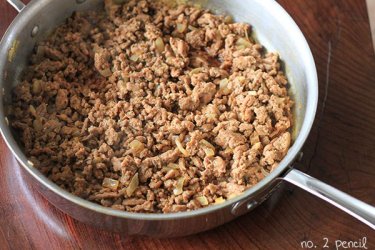- Sep 22, 2013
- 4,956
- 250
- 85
The modern world of culture-exchange propagated by capitalism and the free market perhaps begun during the days of colonialization encourages people to experiment and explore different kinds of culinary preparations from various lands.
This curiosity is not only reflected in formal festivals/holidays such as Thanksgiving but is also imprinted in the pedestrian interests of everyday chefs searching for creative or even eccentric ideas about cooking.
Unusual foods encourage us to make quirky connections between various edible items (or items we've deemed to be edible). For example, we can cite how ground and fried Mexican taco meat resembles in consistency the appearance of a human brain. This could be a nice pedestrian conversation-starter for you and your friends next time you visit a Taco Bell.
So here are some interesting entries I pulled from Wikipedia. Don't forget my Taco Bell joke!
Sweetbreads or ris are culinary names for the thymus (also called throat, gullet, or neck sweetbread) or the pancreas (also called heart, stomach, or belly sweetbread), especially of calf (ris de veau) and lamb (ris d'agneau), and, less commonly, of beef and pork. Various other glands used as food may also be called "sweetbreads," including the parotid gland ("cheek" or "ear" sweetbread), the sublingual glands ("tongue" sweetbreads or "throat bread"), and testicles (cf. Rocky Mountain oyster, prairie oyster, or lamb fries). The "heart" sweetbreads are more spherical in shape, and surrounded symmetrically by the "throat" sweetbreads, which are more cylindrical in shape.
One common preparation of sweetbreads involves soaking in salt water, then poaching in milk, after which the outer membrane is removed. Once dried and chilled, they are often breaded and fried. They are also used for stuffing or in pâtés. They are grilled in many Latin American cuisines, such as in the Argentine asado, and served in bread in Turkish cuisine.
The word "sweetbread" is first attested in the 16th century, but the etymology of the name is unclear. "Sweet" is perhaps used since the thymus is sweet and rich-tasting, as opposed to savory-tasting muscle flesh. "Bread" may come from brede, "roasted meat" or from the Old English brǣd ("flesh" or "meat") (source of information from top: Wikipedia).
Head cheese or brawn is a cold cut that originated in Europe. A version pickled with vinegar is known as souse. Head cheese is not a dairy cheese, but a terrine or meat jelly made with flesh from the head of a calf or pig, or less commonly a sheep or cow, and often set in aspic. The parts of the head used vary, but the brain, eyes, and ears are usually removed. The tongue, and sometimes the feet and heart, may be included. It can also be made from quality trimmings from pork and veal, adding gelatin to the stock as a binder.
Head cheese may be flavored with onion, black pepper, allspice, bay leaf, salt, and vinegar. It is usually eaten cold or at room temperature.
Historically, meat jellies were made of the cleaned (all organs removed) head of the animal, which was simmered to produce stock, a peasant food made since the Middle Ages. When cooled, the stock congeals because of the natural gelatin found in the skull. The aspic may need additional gelatin, or more often, reduction to set properly (source of information from top: Wikipedia).
Goat meat or goat's meat is the meat of the domestic goat (Capra aegagrus hircus). It is often called chevon or mutton when the meat comes from adults, and cabrito, capretto, or kid when from young animals. While "goat" is usually the name for the meat found in common parlance, producers and marketers may prefer to use the French-derived word chevon (from chèvre), since market research in the United States suggests that "chevon" is more palatable to consumers than "goat meat". Cabrito, a word of Spanish origin, refers specifically to young, milk-fed goat. In the English-speaking islands of the Caribbean, and in some parts of Asia, particularly Bangladesh, Nepal, Sri Lanka, Pakistan and India, the word “mutton” is often used to describe both goat and sheep meat, despite its more specific meaning (limited to the meat of adult sheep) in the UK, US, Australia and several other English-speaking countries. While the word "mutton" usually refers to "Goat meat" in Indian Subcontinent (source of information: Wikipedia).

Haggis (Scotland)



This curiosity is not only reflected in formal festivals/holidays such as Thanksgiving but is also imprinted in the pedestrian interests of everyday chefs searching for creative or even eccentric ideas about cooking.
Unusual foods encourage us to make quirky connections between various edible items (or items we've deemed to be edible). For example, we can cite how ground and fried Mexican taco meat resembles in consistency the appearance of a human brain. This could be a nice pedestrian conversation-starter for you and your friends next time you visit a Taco Bell.
So here are some interesting entries I pulled from Wikipedia. Don't forget my Taco Bell joke!
Sweetbreads or ris are culinary names for the thymus (also called throat, gullet, or neck sweetbread) or the pancreas (also called heart, stomach, or belly sweetbread), especially of calf (ris de veau) and lamb (ris d'agneau), and, less commonly, of beef and pork. Various other glands used as food may also be called "sweetbreads," including the parotid gland ("cheek" or "ear" sweetbread), the sublingual glands ("tongue" sweetbreads or "throat bread"), and testicles (cf. Rocky Mountain oyster, prairie oyster, or lamb fries). The "heart" sweetbreads are more spherical in shape, and surrounded symmetrically by the "throat" sweetbreads, which are more cylindrical in shape.
One common preparation of sweetbreads involves soaking in salt water, then poaching in milk, after which the outer membrane is removed. Once dried and chilled, they are often breaded and fried. They are also used for stuffing or in pâtés. They are grilled in many Latin American cuisines, such as in the Argentine asado, and served in bread in Turkish cuisine.
The word "sweetbread" is first attested in the 16th century, but the etymology of the name is unclear. "Sweet" is perhaps used since the thymus is sweet and rich-tasting, as opposed to savory-tasting muscle flesh. "Bread" may come from brede, "roasted meat" or from the Old English brǣd ("flesh" or "meat") (source of information from top: Wikipedia).
Head cheese or brawn is a cold cut that originated in Europe. A version pickled with vinegar is known as souse. Head cheese is not a dairy cheese, but a terrine or meat jelly made with flesh from the head of a calf or pig, or less commonly a sheep or cow, and often set in aspic. The parts of the head used vary, but the brain, eyes, and ears are usually removed. The tongue, and sometimes the feet and heart, may be included. It can also be made from quality trimmings from pork and veal, adding gelatin to the stock as a binder.
Head cheese may be flavored with onion, black pepper, allspice, bay leaf, salt, and vinegar. It is usually eaten cold or at room temperature.
Historically, meat jellies were made of the cleaned (all organs removed) head of the animal, which was simmered to produce stock, a peasant food made since the Middle Ages. When cooled, the stock congeals because of the natural gelatin found in the skull. The aspic may need additional gelatin, or more often, reduction to set properly (source of information from top: Wikipedia).
Goat meat or goat's meat is the meat of the domestic goat (Capra aegagrus hircus). It is often called chevon or mutton when the meat comes from adults, and cabrito, capretto, or kid when from young animals. While "goat" is usually the name for the meat found in common parlance, producers and marketers may prefer to use the French-derived word chevon (from chèvre), since market research in the United States suggests that "chevon" is more palatable to consumers than "goat meat". Cabrito, a word of Spanish origin, refers specifically to young, milk-fed goat. In the English-speaking islands of the Caribbean, and in some parts of Asia, particularly Bangladesh, Nepal, Sri Lanka, Pakistan and India, the word “mutton” is often used to describe both goat and sheep meat, despite its more specific meaning (limited to the meat of adult sheep) in the UK, US, Australia and several other English-speaking countries. While the word "mutton" usually refers to "Goat meat" in Indian Subcontinent (source of information: Wikipedia).

Haggis (Scotland)


